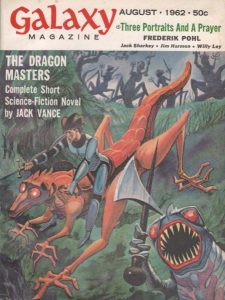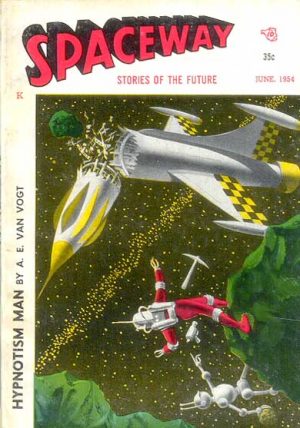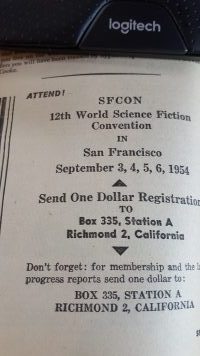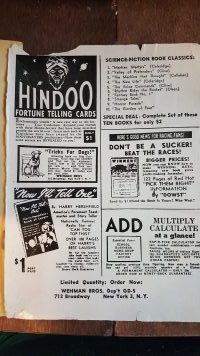Greetings all
Sorry I’m a bit late with this. I caught a bit of con crud at TopCon and was not terribly energetic earlier in the week. Anyway, this week I’ll look at Galaxy, Vol. 20, No. 6 (August, 1962). It’s got quite a few interesting names on the front like Jack Vance and Frederik Pohl and an armored knight charging into battle on odd insect-looking dragons. Right up my alley.

Table of Contents: http://www.isfdb.org/cgi-bin/pl.cgi?58677
This issue starts with an editorial attempting to define progress. It is, not surprisingly, a moving target, and the conclusion is that we need science fiction so we can look at ourselves from the outside. I agree that we need to look at ourselves from the outside, but I’m not sure we needed a 750-word or so editorial to tell us that.
Ah, well. Deadlines make for hurried editorials, as well I remember from my newspaper days way back when.
First is Jack Vance’s novel The Dragon Masters which won the Hugo in 1963 for Best Short Fiction. This is a story consisting of four main foes. Joaz, the protagonist of the story and leader of one faction of humans on Aerlith. Elvis, the leader of the other humans. Then there are the sacerdotes, who view themselves as overmen. Finally there are the Basics, a race of intelligent lizard/insects who live on a different planet that only visit Aerlith when their stars approach each other.
It is from genetically adapted Basic captured in a previous visit that the humans on Aerlith develop a variety of dragons. These dragons are armed with maces on the end of tails and axes on arms. These weapons all go along with the normal spikes, horns, and claws. In return, the Basic developed their own army from genetically altered humans. The sacerdotes have genetically altered themselves and set themselves to a regimen of contemplation and learning.
Humanity as a species is nearly extinct, yet none of the human groups are willing to work with Joaz, though he seeks their help. His desire for assistance is pushed by the approach of the Basic planet. In the end Joaz wins, after a chaotic four-way fight.
One moment that struck me is when a character interacts with a sacerdote. It reminded me of the Readers in my world of Shijuren. People who gather knowledge but stay out of the fray. I did not get the idea from Vance, rather the Readers are a combination of Asimov’s Foundation, Gandalf, and a few other tidbits here and there. It’s fun to see other authors have similar ideas.
However, I did not particularly like this story. Maybe it was the artwork, which was sharp, and odd as you can see from the cover. Jack Gaughan did the artwork and he drew just about every kind of creature involved. The image on the cover was fun and creepy, but by the end of the story had a wrongness.
And that mirrors my view of the story. It was long, almost 90 pages, and I never really got caught up in it. I can see why it won the Hugo, as there are a lot of elements that I suspect many other readers will like, but for me it was a slog. It was perhaps too complex in some ways yet too simplistic in others. I don’t know. In any case, while I normally like Vance, this story didn’t suit me.
Next was Handyman by Frank Banta. I don’t know much about Banta but I liked this story. Unlike The Dragon Masters, Handyman was very short, only three pages. However, that worked for the story. Our hero, James, is constantly chopping up wooden doors so he can burn them for heat. The building’s carpenter cheerily comes to replace it every time. James keeps asking to help with the heating plant, as the carpenter doesn’t have the skills to fix it. However, James is a prisoner and prisoners aren’t allowed to work on things.
Throughout the story, James tries to find solutions to his various problems, but certain things aren’t proper, like him working on the plant. He tries to dig a tunnel, but the foundations of the prison go too deep. He can’t even call for help because he and the carpenter were left behind when all other humans left Earth.
And the carpenter is a robot.
Next comes a science article by Willy Ley. This particular article discusses the odd nautical phenomena of big, bright pinwheels. He goes through all the logged entries of this phenomena, maps them, and then goes through a few ideas of what might cause them.
Humorously, the ISFDB page on our next author, Jack Sharkey, only lists his Danish Wikipedia page. The only Jack Sharkey in the English Wikipedia is a boxer from the 1920s, and he’s an interesting guy too being the only person to fight both Jack Dempsey and Joe Louis.
But I digress. Shocking I know. Anyway, his story is A Matter of Protocol. The story is about making first contact. Humans have developed a system to allow alien zoologists to meld with the minds of creatures on a planet. in this case, the planet is a green jungle where it turns out there are only a few species. These species work in a close symbiotic relationship. Unfortunately, simply landing on the planet ending up damaging some of the trees, and in two months the planet is a lifeless ball.
I have mixed feeling about this story. On the one hand, it’s got a couple of plot holes that I don’t like. The planet only has a few species, and and find that difficult to accept. Two, I grew up in Kansas, where the Flint Hills are routinely control burned because the prairie grass evolved to get hit by lightning and then burn, uncontrolled, so it can refresh itself. I find it challenging to think that the creatures on this planet are so simple to destroy when crazy, accidental stuff is just going to happen.
On the other hand, the story is well-written, innovative, and talks about the tough question of first contact. I’m glad I read it, and I’d like to read more of Sharkey, but this story fought me.
Before I get to the next story, I have to mention the ad on page after Sharkey’s story. For $2.00, you can order a copy of The Complete Guide to Orbiting Satellites. It’s actually loose-leaf, and promises consistent updates. I don’t actually know how many satellites were in orbit in 1962, but it goes over the communication, weather, navigation, and reconnaissance satellites at the time. Even in 1962, I’d have paid $2.00 for that.
Frederik Pohl is next with a story called Three Portraits and a Prayer. Pohl was actually the editor of this issue, but of course he was a fantastic writer. I loved the Heechee series.
But this isn’t his best story. Basically, a dying genius physicist gives an evil billionaire enough knowledge to become dictator, but eventually manages to kill him. This story could have been great, because Pohl’s prose is excellent, but there are two problems. One, it’s message fiction. Knowledge should be free, among other things. Message fiction is not necessarily bad, but the story has to be better, in my opinion. Unfortunately, all the action happens off screen. Our narrator is the genius’s doctor and all we see is what he sees and much of the story is his opinion. I want to see the action, not what someone else knows and thinks of the action.
Jim Harmon is next with Always a Qurono. This is the second time I’ve run across Harmon. He had a story in the Mag Review I did for the Spaceway from June, 1954 that I really liked.
And I liked this story too, though it’s a bit confusing. A crew mutinies and maroons its captain on a planet occupied by Quronos. These are androids developed by someone in the past. They will “geoplanct” and “xenogut” every day on a schedule. The tagline is, “You too can be a Qurono. All you need do is geoplanct. All you need know is when to stop!” The captain emulates the Qurono and they revere him as a master, but then he continues and they realize he’s not actually anything special and they send him into space.
The crew that mutinied had tried to escape, but the Qurono forced them back and they rescue the captain. Then he imposes a new regimen on the crew, forcing them to geoplanct. Reluctantly, the crew obeys.
My confusion is that I simply don’t know what geoplanct or xenogut exactly mean, nor can find them any definition. I suspect Harmon hid some extra punch in those words, but I just don’t know. Still, Harmon is clearly a skilled writer as you are following intently what is going on.
So we move on to the essay The Luck of Magnitudes by George O. Smith. It discusses just how lucky we are that Earth is at the convenient place that it is, not simply for life but also for humanity’s ability to look at space around them, especially the moon. It’s a neat article, more interesting than I expected when I started it, because it involves how ancient astronomers looked at the sky.
The last story in this issue is One Race Show by John Jakes. John Jakes? Yep, the same guy known for historical fiction. I had no idea he wrote SF/F and now I see a lot of stuff I want to read like the Brak the Barbarian series.
Anyway, this is perhaps the perfect story for this issue. It’s about the owner of a gallery jealous because another gallery got amazing pictures from an unknown artist. They discover that the artist is so powerful because he draws what he sees in people’s heads.
It’s the perfect story for this issue because it’s well-written but not enjoyable. At least to me. Other people may find this issue really good, but I’ve found much better.
There are a few more details to discuss. The last section are Floyd C. Gale’s reviews. The most interesting of these is his review of Harry Harrison’s The Stainless Steel Rat, which he really likes.
There’s not many ads in this issue, so other than the ad I mentioned earlier, there’s not much to talk about.
If you have any comments or would like to request I keep my eyes open for a specific issue or month, feel free to comment here or send an email to me at: rob@robhowell.org.
If you want to see previous reviews, the Mag Review category is here: https://robhowell.org/blog/?cat=432.
Have a great day.
Rob Howell
Author of the Shijuren-series of novels
- Website: www.robhowell.org
- Patreon: https://www.patreon.com/rhodri2112
- Blog: www.robhowell.org/blog
- Shijuren Wiki: http://www.shijuren.org/World+
of+Shijuren+Home - MeWe: https://mewe.com/i/rob.howell1
- Facebook Author Page: https://www.facebook.com/robho
well.org/ - Twitter: https://twitter.com/Rhodri2112




